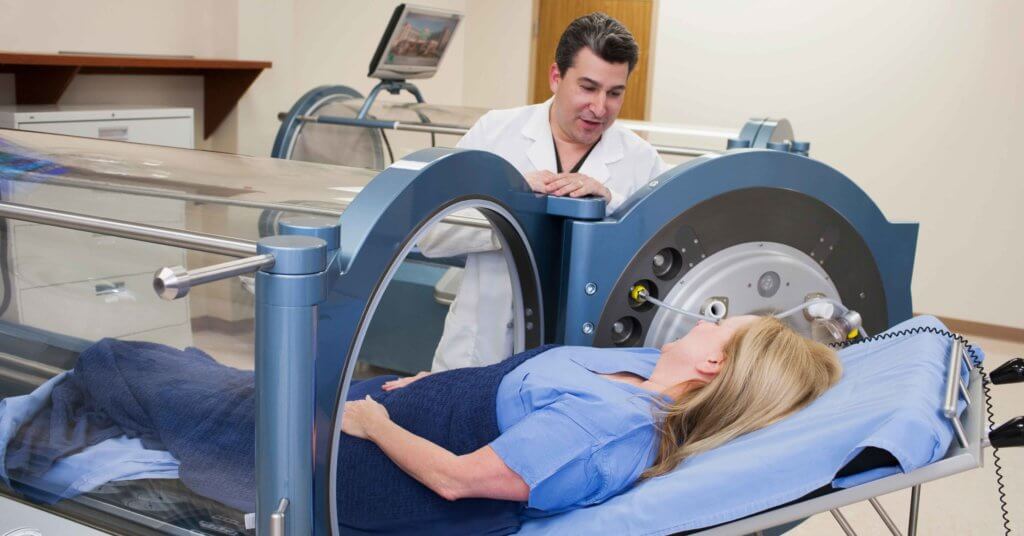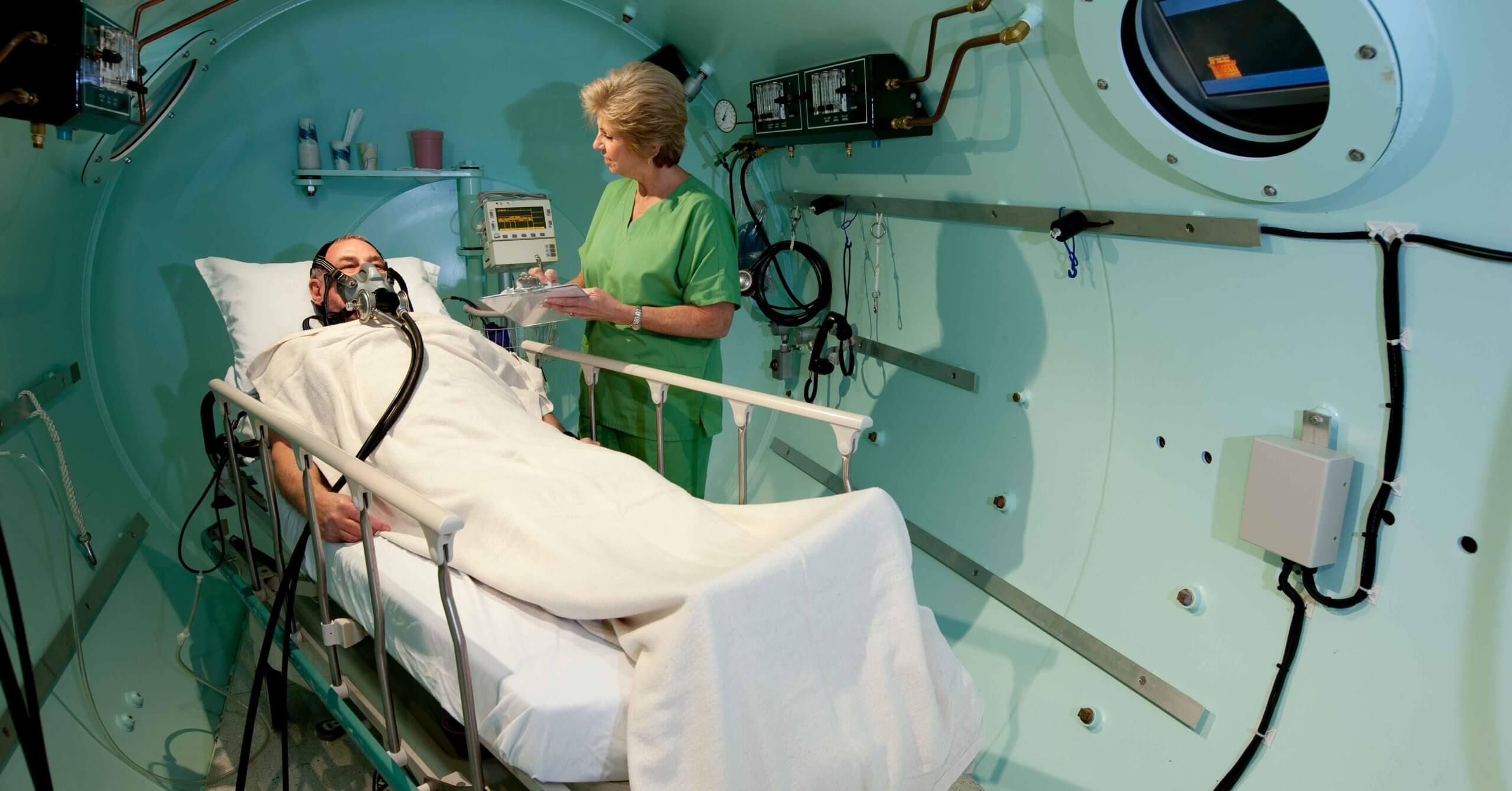When you hear the words hyperbaric oxygen, you probably think of a troubled scuba diver with decompression sickness in need of immediate live-saving medical care.
But hyperbaric oxygen therapy — HBOT for short — is also a go-to therapy routinely used in wound care.
To learn the basics about HBOT, we spoke with wound care experts in the U.S. and abroad.
Hyperbaric Oxygen Therapy Overview
“Hyperbaric oxygen therapy may benefit wound care clinicians in preventing and/or treating various wounds in their patients by increasing oxygen delivered to wound tissue,” said Don Wollheim, MD, FAPWCA, WCC, DWC, a board-certified surgeon of the American Board of Surgery and an instructor with the Wound Care Education Institute (WCEI).
Normally, we breathe room air, which has 21% oxygen, at sea level or one atmospheric pressure, according to Wollheim.
“The oxygen of inhaled air gets into the bloodstream by crossing the membrane between the alveolar sac of the lungs and the capillaries arising from the pulmonary artery,” he said. “Since the inhaled oxygen content in the alveolar sac is greater than that in the capillary, the oxygen diffuses across the membrane going from the alveolus into the capillary.”
The diffusion process is known as Henry’s Law of gas equalization, said Kent MacLaughlin, MS, safety director at Medical Oxygen Outpatient Center in Madison, Wis.
“HBOT has so much oxygen in it, it dissolves in the blood plasma to the tissue through the diffusion process,” MacLaughlin said.
David Teguh, MD, PhD, WCC, of the Amsterdam UMC Department of Surgery and Hyperbaric Medicine in Amsterdam, The Netherlands, added some other insights.
“By optimizing oxygen perfusion in the wound, tissue growth factor is stimulated, antibacterial mechanisms such as ROS and NOS are initiated, and the production of pro-inflammatory cytokines ceases,” Teguh said. “The therapeutic benefit of HBOT has been shown in diabetic ulcers, in anaerobic or severe aerobic infections, and late radiation-induced tissue injury.”
Additional HBOT facts
Hyperbaric oxygen therapy requires no cellular energy (ATP) utilization, and we breathe 100% pure oxygen with the therapy at a higher pressure versus the 21% oxygen found in room air at sea level pressure (1 atmospheric or 1 atm).
More oxygen potentially goes to the tissues via the patient’s circulation, but there will not be a benefit if the native blood flow to the tissue is impeded. HBOT’s effect is independent of the blood’s hemoglobin level because the oxygen is in the plasma and not attached to the hemoglobin molecule.
So why is oxygen important? Cells needed to heal a wound require more energy (ATP molecules) than usual, and oxygen is essential in maximizing ATP production.
Meanwhile, oxygen helps create new blood vessels in the tissue (angiogenesis) and helps decrease swelling of tissue that inhibits healing.
HBOT helps prevent reperfusion injury that could lead to impairment of local capillary blood flow, and it can block the effects of bacteria while improving a patient’s immune system. It also can increase the formation of collagen and cells of the skin.
Condition-Based Recommendations
Teguh said he considers hyperbaric oxygen therapy for “patients with refractory osteomyelitis and/or chronic non-healing (ischemic) wounds if there has not been sufficient healing for a period of at least three months, even with optimal wound care according to the national guidelines in the Netherlands, or if a wound deteriorated dramatically.”
When to initiate HBOT, and in which patients, depends on what the clinician wants to treat or prevent, according to Wollheim.
“There are several wound care-related diagnoses that warrant a different level of urgency and therapy,” he said. “In some conditions, a delay in recognition and therapy can be fatal.”

Common Conditions and Injuries for Hyperbaric Oxygen Therapy
HBOT is commonly used for a variety of conditions and injuries, including:
Clostridial Myositis and Myonecrosis (Gas gangrene)
Therapy should begin as soon as possible and is often typically started after the first surgical debridement.
The condition is an acute and rapidly progressing invasive infection of muscle that involves profound toxemia, massive tissue death and gas production. It occurs rapidly, within hours of injury.
Crush injuries
It is best to begin HBOT when starting overall treatment because of the high rate of complications, including amputation 50% of the time.
HBOT increases oxygen to poorly perfused tissue, reduces edema, and decreases the effects of reperfusion injury. A crush injury is related to trauma of body parts and usually involves the full thickness down to and including bone.
Compartment Syndrome of skeletal muscle
When to start HBOT depends on the classification of the syndrome and might occur before or after a fasciotomy is performed. The syndrome can involve bleeding and edema within a confined fascial space because of trauma.
Ischemia can occur when tissue fluid pressure within compartment exceeds capillary closing pressure.
Problem wounds
All levels of wound healing are oxygen dependent. Chronic wounds often experience overall hypoxia that adversely affects wound healing in a timely fashion. HBOT may restart the healing process.
As per CMS guidelines in the U.S., a diabetic foot ulcer must have failed a 30-day course of adequate wound care before instituting HBOT.
To continue HBOT, the Centers for Medicare and Medicaid Services says patients must show improvement every 30 days.
The best evidence of the therapy’s benefit is the Wagner 3-5 diabetic foot ulcer. Hyperbaric oxygen therapy might need to be combined with revascularization so the oxygenated blood can get to the needy tissue.
The definition of hypoxia in a wound is wound P02 < 40 mm Hg. Wound care clinicians should consider HBOT in patients with arterial ulcerations if non-reconstructable anatomy exists or there is no improvement post-reconstruction.
HBOT also might benefit graft and flap survival in patients with venous and pressure injury diseases and possibly as a separate adjunctive therapy.
Necrotizing soft tissue infections
These are rapid and potentially fatal infections of the superficial soft tissue and its underlying fascia.
Many studies support HBOT benefits with appropriate wound care, and the therapy should start urgently.
Refractory osteomyelitis
This is an infection of the bone or bone marrow. Chronic osteomyelitis persists or recurs after appropriate surgical care or prolonged antibiotic therapy (4-6 weeks).
HBOT can increase tissue blood flow via angiogenesis and is usually administered in conjunction with antibiotic therapy,
Delayed radiation injuries (soft tissue and bony necrosis)
Hyperbaric oxygen therapy is most frequently used in the treatment and prevention of radiation necrosis of the mandible from previous radiation therapy to the head and neck region. For prevention, HBOT can be given before and after dental procedures.
These wounds can occur six or more months after completion of radiation therapy and are related to the effects of radiation therapy of endarteritis and fibrosis, leading to hypoxia.
Compromised grafts and flaps
HBOT should be started at the onset of clinical ischemia.
Usually, no surgical intervention can help with the survival of a failing flap, and a failing graft is related to ischemia of the wound bed of the recipient site.
Thermal burns
These complicated circumferential zones of injury occur around injured tissue. HBOT should be considered for severe burns that are greater than 20% BSA, along with burns involving the hands, face, feet, or perineum.
Therapy might also be used to support the needed skin grafts/flaps.
Possible contraindications
Wollheim said hyperbaric oxygen therapy is contraindicated in patients with an active upper respiratory infection, those with a pneumothorax, and patients with claustrophobia.
Additional contraindications for HBOT are patients with a pacemaker from manufacturers who do not wish to check their device withstanding the pressure, such as Biotronic, according to Teguh.
“We do treat patients with pacemakers/ICD’s of St. Jude, Guidant and Medtronic,” he said.
The concurrent or recent use of some chemotherapeutic agents are contraindicated, and the patient’s left ventricle ejection fraction should be at least 20%, Teguh said.
Take our course on Skin and Wound Management today!
What do you think?

